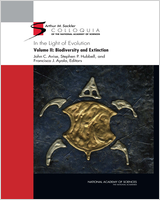From: 9, Extinction as the Loss of Evolutionary History

NCBI Bookshelf. A service of the National Library of Medicine, National Institutes of Health.
| Diversity | Ordovician | Devonian | Permian | Triassic | Cretaceous |
|---|---|---|---|---|---|
| Taxic | 60/26% | 57/22% | 82/52% | 53/22% | 47/16% |
| Phylogenetic | ? | ? | High | ? | ? Medium |
| Morphologic | High | Medium | High | ? | ? Medium |
| Functional | Medium | High | High | Low | Medium |
| Architectural | Medium | High | High | Medium | Low |
| Behavioral | ? | ? | High | Medium | Medium |
| Developmental | Low | ? | Medium | ? | ? |
NOTES: Taxic diversity drops are shown for genera and families from Sepkoski (1996). Estimates of loss of phylogenetic diversity are based on the loss of major clades, as documented by phylogenetic analyses; morphologic disparity is assessed within particular clades, and the loss of major clades; functional diversity is assessed based on published paleoecological studies. Loss of architectural diversity is measured by changes in reef volume and the diversity of reef ecosystems (Wood, 1999; Flügel and Kiessling, 2002). Changes in behavioral diversity were assessed by changes in the complexity of trace fossil assemblages. Developmental diversity was assessed as described. Question marks indicate an absence of sufficient data.
From: 9, Extinction as the Loss of Evolutionary History

NCBI Bookshelf. A service of the National Library of Medicine, National Institutes of Health.